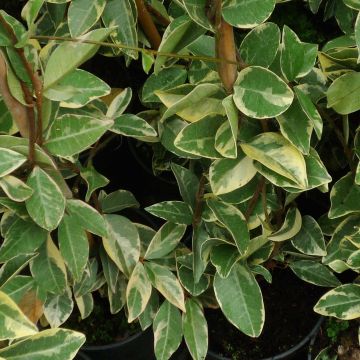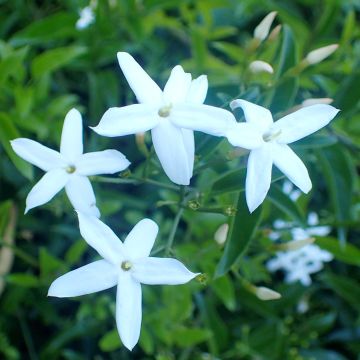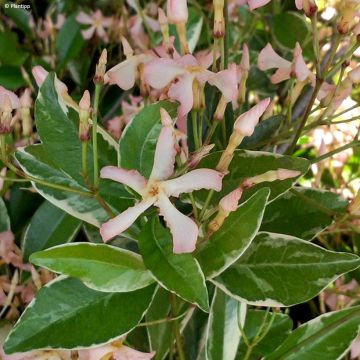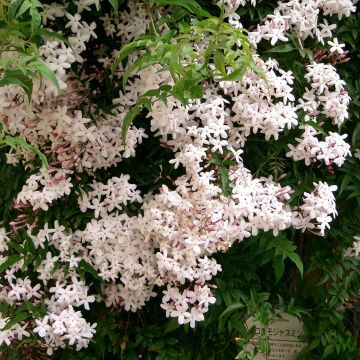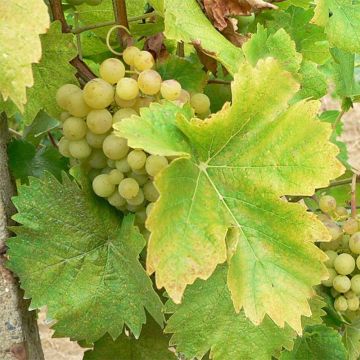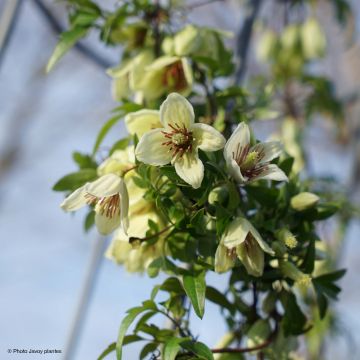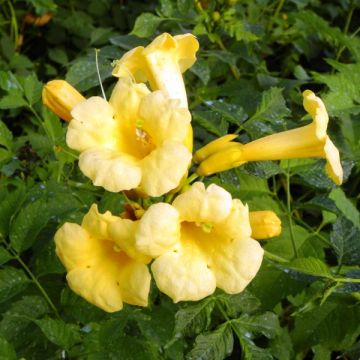

Jasmin - Jasminum grandiflorum


Jasmin - Jasminum grandiflorum
Jasminum grandiflorum - Spanish jasmine
Jasminum grandiflorum
Spanish Jasmine, Royal Jasmine, Catalonian Jasmine, Large-Flowered Jasmine
Purchased in spring in 2/3l, healthy and vigorous plant, potted culture first flowering in September. A bit disappointed with the scent of the first flowers but little sun at the time of flowering.
Seb, 16/12/2024
This item cannot be shipped to the selected country
Delivery charge from €5.90
More information
Delivery charge from €5.90
More information
Schedule delivery date,
and select date in basket
This plant carries a 6 months recovery warranty
More information
We guarantee the quality of our plants for a full growing cycle, and will replace at our expense any plant that fails to recover under normal climatic and planting conditions.
From €5.90 for pickup delivery and €6.90 for home delivery
Express home delivery from €8.90.
Does this plant fit my garden?
Set up your Plantfit profile →
Description
Jasminum grandiflorum, also known as the Spanish Jasmine or Large-Flowered Jasmine, has been cultivated on a large scale for over 3 centuries for the extraction of its extraordinary fragrance. This fragrance is unique and perfectly balanced, being both sweet and powdery, fruity and floral. This jasmine can still be found in the gardens of old farmhouses, forming a dense thicket where its branches intertwine, resembling more of a disordered bush than an elegant climber. Its star-shaped flowers, larger than average for this genus, bloom for a long period, from May to October-November in mild climates. Whether planted in the ground or in a pot on the terrace, adopt this true jasmine for its fragrance!
Jasminum grandiflorum belongs to the olive family. Originally from the western Himalayas, it is spread from northwest India to Pakistan, as well as the Arabian Peninsula, and even Africa, including Sudan, Kenya, Uganda, and Rwanda. Some botanists consider it a subspecies of Jasminum officinale. Less hardy than the latter, J. grandiflorum can be easily grown in the ground in areas where the temperature does not drop below -6°C (21.2°F) for two consecutive weeks. This climbing bush reaches an average height of 3m (10ft) under favourable conditions and spreads over 2.5m (8ft), with a relatively fast growth rate. The flowering period is remarkably long in moist soil, lasting from May to November. In dry and hot climates, it goes through a resting period in July-August and resumes in September with the return of rain. The plant produces loose panicles of 2 to 9 button-like buds at the axils of its leaves or at the end of its branches. These buds open into 5-petaled flowers, measuring 4cm (2in) in width. They are red-pink on the outside and pure white on the inside. The semi-evergreen foliage is composed of pinnate leaves with 5 or 9 small ovate to lanceolate leaflets, with a slightly bluish-green colour. The stems become woody and light brown with age, devoid of leaves. The young branches, which bear the foliage, are green, angular, or channelled.
If guided in its growth, Jasminum grandiflorum can climb over shrubs, trellises, arches, pergolas, stair railings, or balcony railings in favourable climates. As evidenced by old plants growing almost wild in neglected gardens, it is perfectly capable of withstanding neglect and long Mediterranean summers. In colder regions, it can be grown in a container to be moved to a protected area during winter. Place it on the terrace to fully enjoy its unforgettable fragrance, but avoid placing it near a bedroom with an open window; some claim that its scent disrupts sleep and can cause headaches. One of the best uses in the ground is to plant it as part of an evergreen hedge: in winter, its often bare branches blend into the vegetation, while in summer, delicate garlands of light foliage and beautiful white, fragrant stars adorn it with a touch of magic.
Its highly fragrant flowers are used in perfumery, to flavour tea, and are also used in traditional remedies in Asia. The essential oil extracted from these flowers is used in both perfumery and cooking. Its aroma can be found in maraschino cherries.
Jasminum grandiflorum - Spanish jasmine in pictures




Plant habit
Flowering
Foliage
Botanical data
Jasminum
grandiflorum
Oleaceae
Spanish Jasmine, Royal Jasmine, Catalonian Jasmine, Large-Flowered Jasmine
Himalayas
Other Jasmine
Planting and care
Jasminum grandiflorum is planted in the ground preferably in spring in slightly cool areas, or in early autumn in dry and hot climates. It can be planted in pots all year round. Plant it in deep, fertile soil that is kept moist to help it establish. It requires well-drained soil and will thrive in a very sunny and sheltered position, even in partial shade in hot climates. The Spanish Jasmine tolerates the presence of limestone in the soil, but not in excess. Mulch the base and water generously as soon as the flowers appear. When the temperature drops below -6°C/-7°C (19.4°F), the above-ground parts freeze and turn black. However, if the base is well established and protected, new shoots will emerge in spring. Pruning of the oldest stems (brown) is necessary in late winter, at the start of vegetation growth. This plant tolerates drought once established, but will be more floriferous if the soil remains slightly moist. It can tolerate partial shade, but flowering is more abundant in the sun. Avoid exposing it to cold drafts to preserve its flowers. Outside the very warmest areas, place the jasmine against a south-facing wall that will return some of its warmth.
For container cultivation: choose a container 50cm (20in) in size, with good, rich, moist, and light soil, specifically for Mediterranean plants. From early spring until mid-September, enrich with liquid fertiliser every 15 days, always on moist soil. In summer, it needs abundant watering, but in winter, let the soil dry well between two waterings. Jasmine is very vigorous even in a pot and can become bare at the base. In this case, prune the old branches to leave only 3 young shoots. In winter, place it in a veranda or a temperate greenhouse, around 16°C (60.8°F), with plenty of light. Regularly spray the foliage with lime-free water to prevent attacks from red spider mites.
Planting period
Intended location
Care
-
, onOrder confirmed
Reply from on Promesse de fleurs
Mediterranean climbers
Haven't found what you were looking for?
Hardiness is the lowest winter temperature a plant can endure without suffering serious damage or even dying. However, hardiness is affected by location (a sheltered area, such as a patio), protection (winter cover) and soil type (hardiness is improved by well-drained soil).

Photo Sharing Terms & Conditions
In order to encourage gardeners to interact and share their experiences, Promesse de fleurs offers various media enabling content to be uploaded onto its Site - in particular via the ‘Photo sharing’ module.
The User agrees to refrain from:
- Posting any content that is illegal, prejudicial, insulting, racist, inciteful to hatred, revisionist, contrary to public decency, that infringes on privacy or on the privacy rights of third parties, in particular the publicity rights of persons and goods, intellectual property rights, or the right to privacy.
- Submitting content on behalf of a third party;
- Impersonate the identity of a third party and/or publish any personal information about a third party;
In general, the User undertakes to refrain from any unethical behaviour.
All Content (in particular text, comments, files, images, photos, videos, creative works, etc.), which may be subject to property or intellectual property rights, image or other private rights, shall remain the property of the User, subject to the limited rights granted by the terms of the licence granted by Promesse de fleurs as stated below. Users are at liberty to publish or not to publish such Content on the Site, notably via the ‘Photo Sharing’ facility, and accept that this Content shall be made public and freely accessible, notably on the Internet.
Users further acknowledge, undertake to have ,and guarantee that they hold all necessary rights and permissions to publish such material on the Site, in particular with regard to the legislation in force pertaining to any privacy, property, intellectual property, image, or contractual rights, or rights of any other nature. By publishing such Content on the Site, Users acknowledge accepting full liability as publishers of the Content within the meaning of the law, and grant Promesse de fleurs, free of charge, an inclusive, worldwide licence for the said Content for the entire duration of its publication, including all reproduction, representation, up/downloading, displaying, performing, transmission, and storage rights.
Users also grant permission for their name to be linked to the Content and accept that this link may not always be made available.
By engaging in posting material, Users consent to their Content becoming automatically accessible on the Internet, in particular on other sites and/or blogs and/or web pages of the Promesse de fleurs site, including in particular social pages and the Promesse de fleurs catalogue.
Users may secure the removal of entrusted content free of charge by issuing a simple request via our contact form.

































